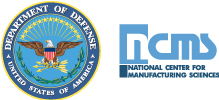055 – “LASER Coating Removal System (RLCRS)”
Author: Richard Crowther
Company: USAF
Phone: (801) 586-5361
Email: richard.crowther@us.af.mil
Ogden Air Logistics Complex (OO-ALC) has made great strides in the last few years with robotic LASER coating removal technology. Incredible efforts from Engineers, Technicians, 309 AMXG, Department of Defense (DoD) contractors, Air Force Life Cycle Management Center / Enterprise Zone Program, and OO-ALC leadership have led to a viable and fully capable technology that is in use today. Robotic LASER Coating Removal System (RLCRS) for the F-16 aircraft became focus at OO-ALC during the 3rd quarter of 2017. To date, 12 production F-16 aircraft have been processed using OO-ALC’s RLCRS to remove their coatings. All 12 aircraft have returned to service to continue their mission.
A RLCRS was installed at Hill Air Force Base (AFB) in 2014 for implementation and optimization. The technology was introduced for the purpose of increasing employee safety, increasing production machine throughput, reducing environmental impact, and eliminate substrate degradation damage caused by the PMB process.
OO-ALC has used plastic media blasting (PMB) as the primary method of aircraft coating removal for decades. While it has been an effective method of removing aircraft coatings, it has several negative second and third order effects. The PMB process is very resource intensive, requiring 5-7 technicians to mask/seal, remove coatings, and de-prep the aircraft; requires full personal protective equipment (PPE) garb to prevent exposure to the Hexavalent Chromium and Cadmium hazardous waste the process generates; additionally, technicians must endure the physical demands of holding and maneuvering heavy blast hoses. Approximately 2000 lbs. of waste material is generated each time an F-16 aircraft uses PMB to remove coatings. This waste is captured via the PMB booth dust collection system and deposited into large containment bags, which are disposed of as hazardous waste.
For F-16, the RLCRS has proven through testing, evaluation, and optimization to: remove the worker from the hazardous environment; reduce the hazardous waste from 2000 lbs. to 10-12 lbs. per aircraft; reduce the process man-hours by 30-50%; eliminate 2-3 flow days; and shows no negative impact to the airworthiness of the aircraft.
Leveraging the success of the RLCRS within OO-ALC at Hill AFB, there are several follow on programs in work to propagate the technology. Building 269 at Hill AFB is being repurposed for a RLCRS that is capable of supporting: F-16, A-10, F-22 and F-35 AC. OO-ALC’s Aerospace Maintenance and Regeneration Group (AMARG) at Davis Monthan AFB, is currently planning to implement a RLCRS capable of supporting a variety of DoD weapon system platforms. Warner Robins ALC is looking at the feasibility and planning for possible RLCRS(s) for F-15, Global Hawk and C-130 aircraft.

